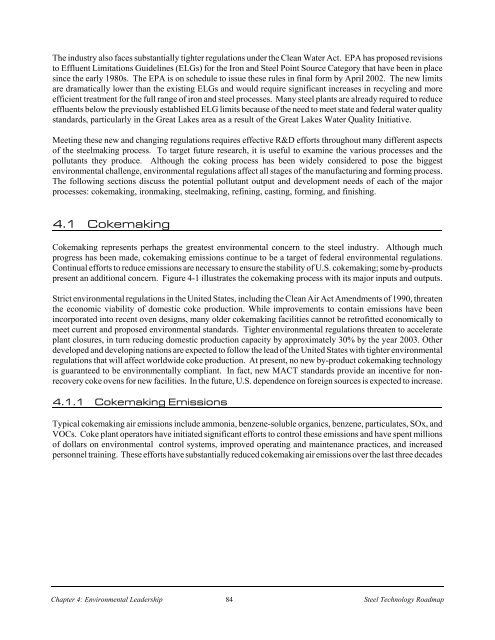ITP Steel: Steel Technology Roadmap -- Chapter Four ... - EERE
ITP Steel: Steel Technology Roadmap -- Chapter Four ... - EERE
ITP Steel: Steel Technology Roadmap -- Chapter Four ... - EERE
You also want an ePaper? Increase the reach of your titles
YUMPU automatically turns print PDFs into web optimized ePapers that Google loves.
The industry also faces substantially tighter regulations under the Clean Water Act. EPA has proposed revisionsto Effluent Limitations Guidelines (ELGs) for the Iron and <strong>Steel</strong> Point Source Category that have been in placesince the early 1980s. The EPA is on schedule to issue these rules in final form by April 2002. The new limitsare dramatically lower than the existing ELGs and would require significant increases in recycling and moreefficient treatment for the full range of iron and steel processes. Many steel plants are already required to reduceeffluents below the previously established ELG limits because of the need to meet state and federal water qualitystandards, particularly in the Great Lakes area as a result of the Great Lakes Water Quality Initiative.Meeting these new and changing regulations requires effective R&D efforts throughout many different aspectsof the steelmaking process. To target future research, it is useful to examine the various processes and thepollutants they produce. Although the coking process has been widely considered to pose the biggestenvironmental challenge, environmental regulations affect all stages of the manufacturing and forming process.The following sections discuss the potential pollutant output and development needs of each of the majorprocesses: cokemaking, ironmaking, steelmaking, refining, casting, forming, and finishing.4.1 CokemakingCokemaking represents perhaps the greatest environmental concern to the steel industry. Although muchprogress has been made, cokemaking emissions continue to be a target of federal environmental regulations.Continual efforts to reduce emissions are necessary to ensure the stability of U.S. cokemaking; some by-productspresent an additional concern. Figure 4-1 illustrates the cokemaking process with its major inputs and outputs.Strict environmental regulations in the United States, including the Clean Air Act Amendments of 1990, threatenthe economic viability of domestic coke production. While improvements to contain emissions have beenincorporated into recent oven designs, many older cokemaking facilities cannot be retrofitted economically tomeet current and proposed environmental standards. Tighter environmental regulations threaten to accelerateplant closures, in turn reducing domestic production capacity by approximately 30% by the year 2003. Otherdeveloped and developing nations are expected to follow the lead of the United States with tighter environmentalregulations that will affect worldwide coke production. At present, no new by-product cokemaking technologyis guaranteed to be environmentally compliant. In fact, new MACT standards provide an incentive for nonrecoverycoke ovens for new facilities. In the future, U.S. dependence on foreign sources is expected to increase.4.1.1 Cokemaking EmissionsTypical cokemaking air emissions include ammonia, benzene-soluble organics, benzene, particulates, SOx, andVOCs. Coke plant operators have initiated significant efforts to control these emissions and have spent millionsof dollars on environmental control systems, improved operating and maintenance practices, and increasedpersonnel training. These efforts have substantially reduced cokemaking air emissions over the last three decades<strong>Chapter</strong> 4: Environmental Leadership 84 <strong>Steel</strong> <strong>Technology</strong> <strong>Roadmap</strong>
















